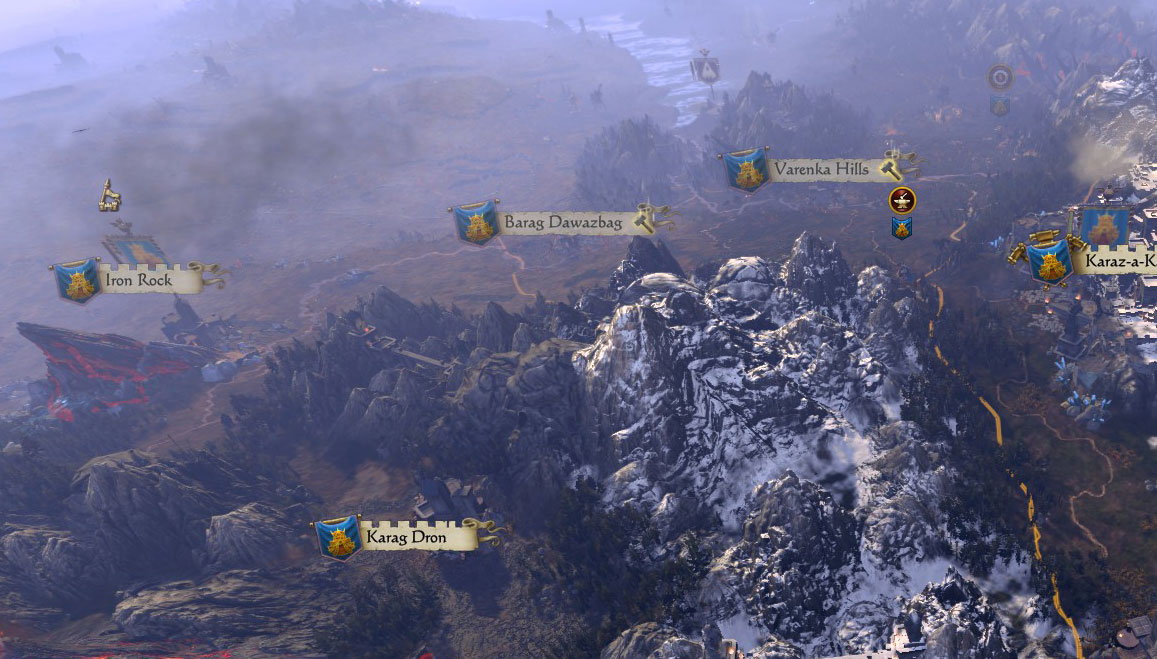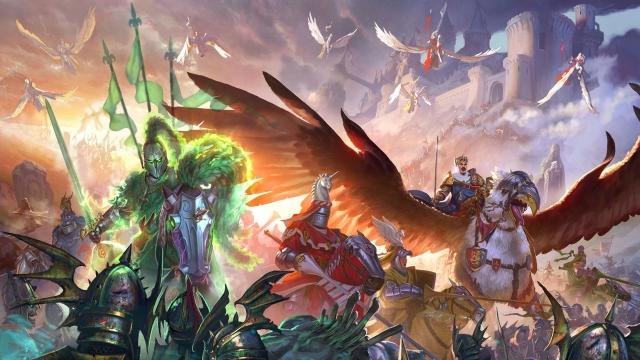I had some very nice things to say about Total War: Warhammer a year ago when I reviewed it, but over the last week I thought I’d check back in and see how it was faring after 12 months of updates and DLC. I was happy to find that a very good game has got even better.
[referenced url=”https://www.kotaku.com.au/2016/05/total-war-warhammer-the-kotaku-review/” thumb=”https://i.kinja-img.com/gawker-media/image/upload/t_ku-large/vkk88edxj15j8tzszaa2.jpg” title=”Total War: Warhammer: The Kotaku Review” excerpt=”I was so ready to hate this game.”]
In the time between launch and July 2017 Creative Assembly have released a ton of new content for the game, some of it free and minor (such as new Lords for certain factions), some of it costing money but certainly more ambitious (and generous) than we’re used to from Total War games.
The best of these are packs which added not just entirely new factions for players to control (such as Beastmen and Wood Elves), but a new way to play them. In addition to letting you choose them as your side in the main story from the original game, you could also elect to play in smaller, more intimate campaigns, similar to the type that CA used to release as standalones (such as Napoleon’s Peninsula War).
The last such release was Bretonnia (which was actually free), and I’ve found it’s the best of the bunch. While not quite as unique as the all-new Beastmen and Elves, since they’re just a very French flavour of the existing human races, I found the changes they made to the way you approach the game fascinating.
When you play as Bretonnia, everything you’ve learned about the game gets thrown out the window. They have a cap on the number of units they can raise, because every man with a sword in his hand isn’t out in the fields farming his harvest. They’re powered as much by acts of chivalry as coin, so you have to be more careful making decisions such as whether to kill prisoners or not. And their position at the edge of the map means you spend much of the game on grand crusades in foreign lands, rather than fighting to protect your borders.
I had a blast learning all the new various strategies that went along with this, which I’ve found has been one of Warhammer‘s real strengths: The ability to finish it then immediately want to restart as someone else and experience a very different way of playing the same game. The fun I had has me suddenly looking forward to the upcoming release of the Norsca pack, something I’d completely overlooked until now, who are also promising to shake things up (you can, for example, defeat then tame the giant monsters of the north and have them fight for you).
Aside from the new stuff, I went back to Warhammer having revisited a number of other Total War games over the past month (from Empire to Shogun to Rome 2), and having played the older games so recently, it really struck me just how good even Warhammer‘s base experience is compared to the games that came before it.
Going back to Empire, Napoleon, even Shogun 2‘s excellent Fall of the Samurai, I was reminded of how Warhammer of all things had allowed Creative Assembly to fix so many of the fundamental issues those games had suffered through. Army spam is gone, but taken care of much more neatly than Rome 2‘s brutal solution. Trading for actual items makes more sense. Creating races that have their own diplomatic and colonisation options brings a real flavour to the way games shake down. And the way army leaders are now full-blown personalities, with loot and gear to equip, makes them feel much more personal.

I love this part of the map so much.
The thing I still like most, though, is the game world itself, and how the map feels real, and alive. I just finished up a successful campaign as the Dwarves, and actually felt like I’d been hunkered down in a mountain stronghold, towering over the rest of the world. It had elevation, and substance, and weight, and even character, with its craggly peaks littered with old ruins, waterways and statues. It didn’t feel like a random piece of art that I just happened to be inhabiting, a particular piece of a map that looked the same across its breadth, it felt like my home. I hope Creative Assembly never go back to their older, flatter maps, even in historical games.
The Norsca pack will probably be my/our farewell to Warhammer as it exists today; Warhammer 2 is out soon, and it will take us to new lands with new factions (and hopefully an even defter refinement of the series’ fundamentals). What’s most interesting about the speed of Warhammer 2 landing, and most relevant to my refreshed praise of the first Warhammer here, is that these quick-fire sequels (such as Napoleon, or Shogun’s two add-ons) used to be the place where you’d get the game-changing content and new factions.
Here, we got a whole bunch of them before the sequel, which itself is bringing a load of fresh stuff only a year later. It’s a pleasant reversal of a practice that fans have long criticised Creative Assembly for, and it’s the one time I’m going to put aside the “there are too many Warhammer games” rule.
When Warhammer 2 is released in September, it will benefit from something Total War fans haven’t felt since the Shogun days: A sense that the series knows where it’s going and how to get there not just confidently, but in style.

Comments
8 responses to “Total War: Warhammer Has Gotten So Good”
GIVE ME TOMB KINGS!!!!!!!
they might be the first DLC pack for game 2 because it does add the southlands. well thats the popular opinion of the offical Total War sub Reddit
Yeah I’d lock Tomb Kings in for DLC 1 of game 2. All new faction packs will contain 4 legendary lords from the start too.
when the combined map comes out im going be so torn on which race to play.. Vampire counts or lizardmen. Ive also heard rumors that there might even be a race of Man sized Rats will be playable, but that is just absurb
HERETIC! thy speaks heresy of mythical giant rat men! to the rack with you !
Having Chaos as a preorder bonus/paid DLC was the most ridiculous thing they did with that game.
sounds like they learned their lesson
i have to say im looking forward to a giant grand campaign eventually with all 3 games 😀